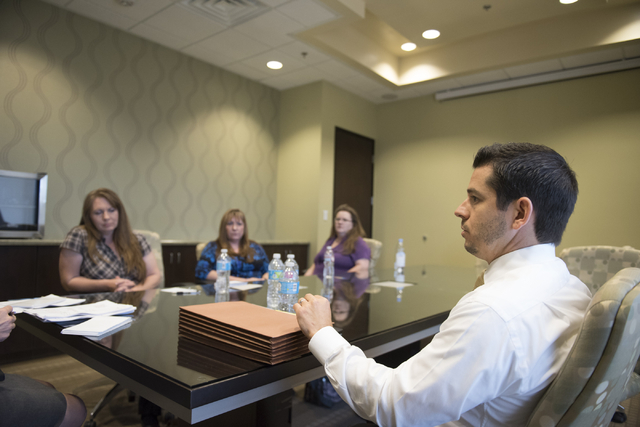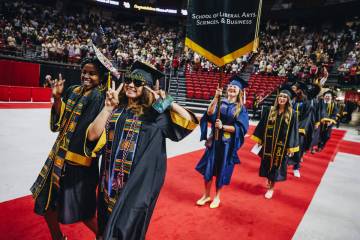Tissue donation turns into nightmare for three sisters
Within hours of Judith Bennett’s unexpected death on Sept. 23, 2013, one of her three adult daughters received a call from the Nevada Donor Network.
Because Bennett was not a registered organ donor, the nonprofit organization needed a family member’s consent to harvest tissue from her body.
Kristine Fagone said she talked the matter over with her two sisters, and they agreed to “give the gift of donation,” with one caveat: They wanted assurances that no one at the upcoming viewing would be able to detect that tissue had been removed from their mother’s body.
“We needed her to look like her,” Fagone said.
Bennett’s oldest daughter, Jerilyn Bennett, said open caskets are customary in her family, and because her mother died so suddenly, “family really needed to have closure through the viewing.” That was especially true for out-of-town relatives, she said.
The daughters say they based their decision to donate on comments from the Nevada Donor Network representative who told Fagone that her mother would “look just the same” after the procedure.
But Bennett’s daughters were shocked by what they discovered when they went to the funeral home to prepare their mother’s body for the viewing. They would later allege in a lawsuit against the Nevada Donor Network that the organization “exceeded the scope of their consent and substantially disfigured their mother’s body.”
The lawsuit’s claims include fraud, intentional infliction of emotional distress and mishandling of a decedent’s remains.
“As far as I know, this is the first case of its kind in Nevada,” said Las Vegas attorney Gregory Coyer, who represents Bennett’s daughters.
According to a recent court document prepared by Coyer, the Nevada Donor Network’s representations to Fagone “were made in order to induce consent, were false, misleading, contained material misrepresentations and omissions of fact, and were undertaken in bad faith.”
In March, District Judge Joe Hardy denied a motion to dismiss the complaint.
Attorney Robert McBride, who represents the defendant, said he cannot comment on pending litigation.
“However, I can say that we intend on vigorously defending these unfounded allegations against Nevada Donor Network in court.”
The organization’s website addresses what it describes as a common “myth” about donation: that someone who agrees to donate organs, eyes or tissues won’t be able to have an open casket funeral.
“Throughout the process, a donor’s body is treated with respect and dignity,” the website says. “Organs and tissues are recovered in a surgical procedure and all incisions are closed and dressed. Every effort will be made to minimize changes to the physical appearance.”
Fagone, 43, of Henderson and her two sisters, Karen Jones, 48, of Boulder City and Jerilyn Bennett, 50, of Henderson, recently discussed their case during an interview at Coyer’s law office. The women were raised in Southern Nevada by their single mother, a Henderson resident who died at age 68 after suffering an aortic dissection.
Bennett’s organs weren’t eligible for donation, but Fagone agreed to donate some of her mother’s tissue: skin, long bones and corneas. According to the lawsuit, Fagone was told during recorded phone conversations that a strip of skin, “about as thick as when you get a sunburn,” would be taken off the back of each leg and that the femurs, tibias and fibulas would be replaced with “artificial bone.”
But the lawsuit alleges the Nevada Donor Network “took more tissue than what was authorized, including additional skin, and all the connective tissue in the lower extremities, tissue which is necessary for the human body to have a ‘normal’ appearance.”
Bennett’s daughters later visited Palm Mortuary on Main Street, where they planned to style their mother’s hair, apply her makeup, paint her nails and make a memorial cast of her hands.
“Seeing a deceased body was not something new to us,” Jerilyn Bennett said.
She said the women had done memorial castings, which they consider “very special,” for others in the past.
“It’s something you can actually hold,” Jones said. “It’s like you’re holding their hand forever.”
At the funeral home, Bennett’s body had been covered with a brown blanket, which seemed normal enough. But as the women began readying their tools, Fagone asked her oldest sister to remove their mother’s toenail polish.
Jerilyn Bennett recalls lifting the blanket and remarking, “Oh, that doesn’t look right.”
She said her mother’s feet were “abnormally flopped over to the side,” and her legs “had been stumped.” She said her mother was already short, but now her legs were a foot shorter.
Jerilyn Bennett said she touched a leg, and it felt to her like the bones had been replaced with PVC pipe. Jones, who began taking pictures, said only her mother’s upper body had been embalmed, making it appear abnormally large.
And the entire body was enclosed in a solid piece of white clothing, similar to an infant’s footed sleeper.
“To me, her feet didn’t even look attached,” Fagone said.
The lawsuit describes what happened next: “The horrifying discovery caused such emotional distress that all plaintiff Fagone could do was lay her head on her mother’s chest, cry, and apologize for allowing NDN to mutilate her mother’s body.”
Fagone said she had made it clear to Nevada Donor Network that she wanted to paint her mother’s toenails for the viewing and that she wanted her mother to wear a sleeveless dress.
The dress was significant because Bennett had worn it a few months earlier to her 50th class reunion in Grand Junction, Iowa, and, according to the lawsuit, had stated that it “was the dress in which she felt the most beautiful she had ever felt.”
“You could tell in the spring in her step that she really felt good in that dress,” Fagone said.
But Bennett would not get to wear that dress one last time. A Palm Mortuary representative told the daughters she needed to be covered from “neck to wrist to toes.”
“Her body was in no condition to be in a sundress,” said Jerilyn Bennett, who still recites the phrase “neck to wrist to toes” as if it were a chant.
And as the viewing approached, the daughters learned that their mother’s body was leaking embalming fluid.
“The day before the viewing, plaintiffs received yet another call from the funeral home stating that they might not be able to have an open casket service because the smell of the leaking body and the embalming fluid might overwhelm the guests at the service,” the lawsuit said.
The day of the viewing, the daughters checked on their mother to make sure she was presentable before deciding to proceed. Even then, they had to direct guests to touch only her hands or face.
To this day, the daughters don’t know what their mother’s body looked like underneath its covering.
“That’s all left up to our memories and nightmares,” Jerilyn Bennett said.
But Coyer argues that Bennett’s body would not have been leaking embalming fluid if the Nevada Donor Network had removed only the thin layer of skin its representative had described.
According to the lawsuit, the organization’s treatment of Bennett’s body “caused the already stressful and emotional time of preparing a loved one’s funeral to be magnified exponentially.”
To make matters worse, Fagone said, she never received the information she had been promised about how her mother’s tissue had been used.
“They robbed us of the good feeling we were supposed to get,” she said.
Fagone said she later shared her concerns with the organization and received permission to give a presentation to its staff. She wanted to explain what had happened and how it had affected her family in hopes that it would lead to improvements in the procurement process.
She said she spoke to about 14 people, but none of the technicians who had worked on her mother’s body were in the group.
Fagone said she also had asked to be notified of future changes in the process, but that didn’t happen.
“We just want them to do what’s ethically right,” she said. That, she added, includes “full disclosure.”
Because of their experience, Fagone and Jones have pulled their names from the organ donor registry. Jerilyn Bennett, once open to the idea of being an organ donor, has ruled it out.
Coyer, who remains in the registry, said he has learned much about organ and tissue donation while researching the case, and the distinction between the two “could not be more stark.”
“Tissue procurement, processing and distribution is actually a billion-dollar for-profit industry, operating in a gray area of legality, and very poorly understood by the vast majority of Americans,” says the lawsuit, which indicates that human tissue can be turned into lucrative medical devices.
Coyer said those who opt to become organ donors at the Nevada Department of Motor Vehicles and have the related heart symbol added to their driver’s licenses have agreed to donate without limitations.
But registration forms on both the DMV’s and the Nevada Donor Network’s websites allow donors to list specific organs and tissues they do not wish to donate. The forms also allow donors to indicate that they do not want their donation to be used for research.
And in cases, such as Bennett’s, where the person who died has not made the choice to register as an organ donor, Nevada law allows certain relatives to give consent over the phone. Coyer said that conversation typically occurs soon after the unexpected death of a loved one, as it did for Fagone.
“I do believe it’s possible to donate tissue and still have an open casket funeral without disfigurement,” the attorney said.
According to the Nevada Donor Network, the state has more than 887,000 registered donors, and 553 Nevadans out of 121,859 Americans are waiting for a transplant.
“We don’t want people to stop donating,” Coyer said. “This lawsuit is about informed consent.”
Contact Carri Geer Thevenot at cgeer@reviewjournal.com or 702-384-8710. Find @CarriGeer on Twitter.




































